Abstract
Vitamin E in the reduced, alpha-tocopherol form shows very modest anticlotting activity. By contrast, vitamin E quinone is a potent anticoagulant. This observation may have significance for field trials in which vitamin E is observed to exhibit beneficial effects on ischemic heart disease and stroke. Vitamin E quinone is a potent inhibitor of the vitamin K-dependent carboxylase that controls blood clotting. A newly discovered mechanism for the inhibition requires attachment of the active site thiol groups of the carboxylase to one or more methyl groups on vitamin E quinone. The results from a series of model reactions support this interpretation of the anticlotting activity associated with vitamin E.
Full text
PDF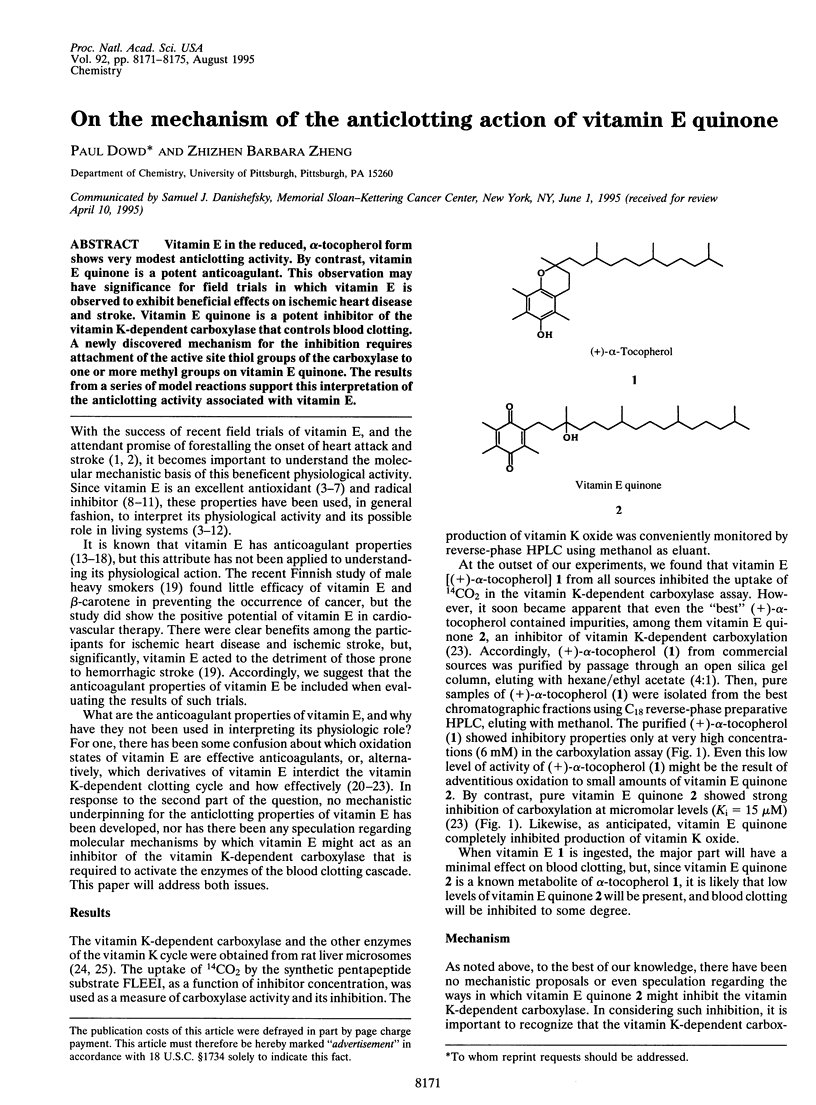
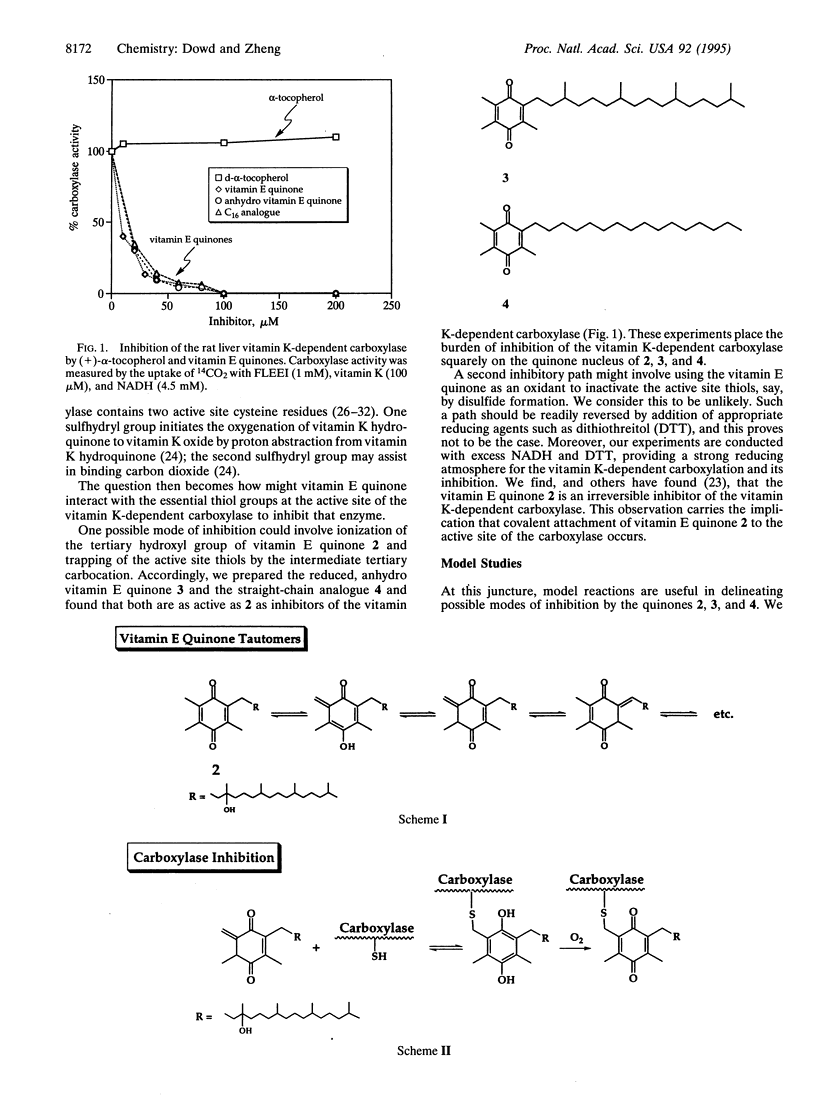
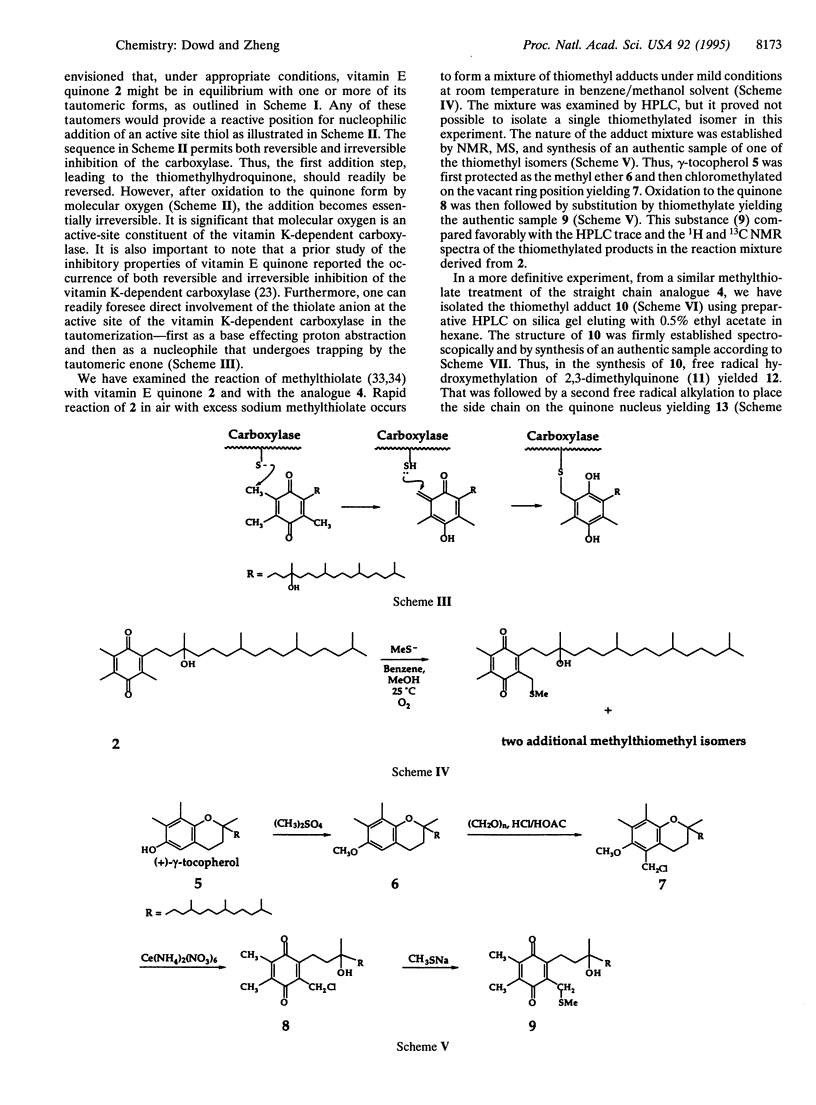
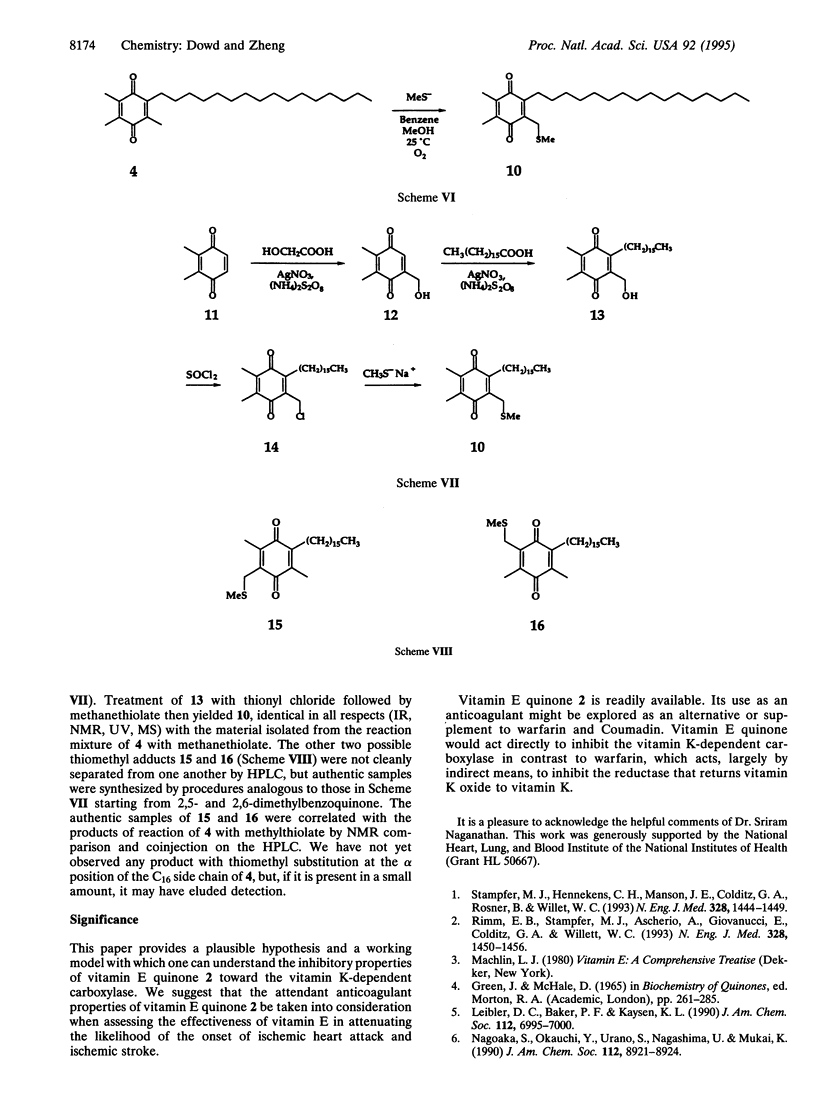
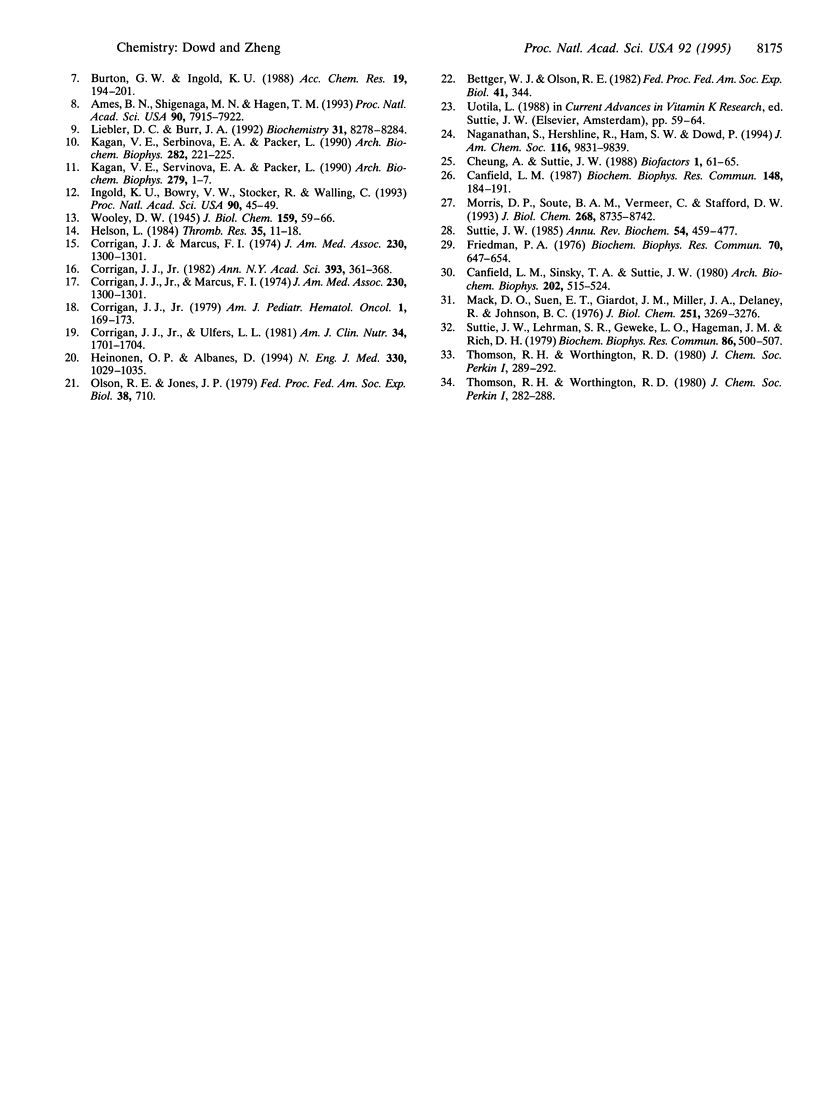
Selected References
These references are in PubMed. This may not be the complete list of references from this article.
- Ames B. N., Shigenaga M. K., Hagen T. M. Oxidants, antioxidants, and the degenerative diseases of aging. Proc Natl Acad Sci U S A. 1993 Sep 1;90(17):7915–7922. doi: 10.1073/pnas.90.17.7915. [DOI] [PMC free article] [PubMed] [Google Scholar]
- Canfield L. M., Sinsky T. A., Suttie J. W. Vitamin K-dependent carboxylase: purification of the rat liver microsomal enzyme. Arch Biochem Biophys. 1980 Jul;202(2):515–524. doi: 10.1016/0003-9861(80)90457-9. [DOI] [PubMed] [Google Scholar]
- Canfield L. M. Vitamin K-dependent oxygenase/carboxylase; differential inactivation by sulfhydryl reagents. Biochem Biophys Res Commun. 1987 Oct 14;148(1):184–191. doi: 10.1016/0006-291x(87)91093-x. [DOI] [PubMed] [Google Scholar]
- Cheung A., Suttie J. W. Synthesis of menaquinone-2 derivatives as substrates for the liver microsomal vitamin K-dependent carboxylase. Biofactors. 1988 Jan;1(1):61–65. [PubMed] [Google Scholar]
- Corrigan J. J., Jr Coagulation problems relating to vitamin E. Am J Pediatr Hematol Oncol. 1979 Summer;1(2):169–173. [PubMed] [Google Scholar]
- Corrigan J. J., Jr, Marcus F. I. Coagulopathy associated with vitamin E ingestion. JAMA. 1974 Dec 2;230(9):1300–1301. [PubMed] [Google Scholar]
- Corrigan J. J., Jr, Marcus F. I. Coagulopathy associated with vitamin E ingestion. JAMA. 1974 Dec 2;230(9):1300–1301. [PubMed] [Google Scholar]
- Corrigan J. J., Jr The effect of vitamin E on warfarin-induced vitamin K deficiency. Ann N Y Acad Sci. 1982;393:361–368. doi: 10.1111/j.1749-6632.1982.tb31275.x. [DOI] [PubMed] [Google Scholar]
- Corrigan J. J., Jr, Ulfers L. L. Effect of vitamin E on prothrombin levels in warfarin-induced vitamin K deficiency. Am J Clin Nutr. 1981 Sep;34(9):1701–1705. doi: 10.1093/ajcn/34.9.1701. [DOI] [PubMed] [Google Scholar]
- Friedman P. A., Shia M. Some characteristics of a vitamin K-dependent carboxylating system from rat liver microsomes. Biochem Biophys Res Commun. 1976 May 17;70(2):647–654. doi: 10.1016/0006-291x(76)91096-2. [DOI] [PubMed] [Google Scholar]
- Helson L. The effect of intravenous vitamin E and menadiol sodium diphosphate on vitamin K dependent clotting factors. Thromb Res. 1984 Jul 1;35(1):11–18. doi: 10.1016/0049-3848(84)90308-6. [DOI] [PubMed] [Google Scholar]
- Ingold K. U., Bowry V. W., Stocker R., Walling C. Autoxidation of lipids and antioxidation by alpha-tocopherol and ubiquinol in homogeneous solution and in aqueous dispersions of lipids: unrecognized consequences of lipid particle size as exemplified by oxidation of human low density lipoprotein. Proc Natl Acad Sci U S A. 1993 Jan 1;90(1):45–49. doi: 10.1073/pnas.90.1.45. [DOI] [PMC free article] [PubMed] [Google Scholar]
- Kagan V. E., Serbinova E. A., Packer L. Recycling and antioxidant activity of tocopherol homologs of differing hydrocarbon chain lengths in liver microsomes. Arch Biochem Biophys. 1990 Nov 1;282(2):221–225. doi: 10.1016/0003-9861(90)90108-b. [DOI] [PubMed] [Google Scholar]
- Liebler D. C., Burr J. A. Oxidation of vitamin E during iron-catalyzed lipid peroxidation: evidence for electron-transfer reactions of the tocopheroxyl radical. Biochemistry. 1992 Sep 8;31(35):8278–8284. doi: 10.1021/bi00150a022. [DOI] [PubMed] [Google Scholar]
- Liochev S. I., Fridovich I. Vanadate-stimulated oxidation of NAD(P)H in the presence of biological membranes and other sources of O2-. Arch Biochem Biophys. 1990 May 15;279(1):1–7. doi: 10.1016/0003-9861(90)90454-7. [DOI] [PubMed] [Google Scholar]
- Mack D. O., Suen E. T., Girardot J. M., Miller J. A., Delaney R., Johnson B. C. Soluble enzyme system for vitamin K-dependent carboxylation. J Biol Chem. 1976 Jun 10;251(11):3269–3276. [PubMed] [Google Scholar]
- Morris D. P., Soute B. A., Vermeer C., Stafford D. W. Characterization of the purified vitamin K-dependent gamma-glutamyl carboxylase. J Biol Chem. 1993 Apr 25;268(12):8735–8742. [PubMed] [Google Scholar]
- Rimm E. B., Stampfer M. J., Ascherio A., Giovannucci E., Colditz G. A., Willett W. C. Vitamin E consumption and the risk of coronary heart disease in men. N Engl J Med. 1993 May 20;328(20):1450–1456. doi: 10.1056/NEJM199305203282004. [DOI] [PubMed] [Google Scholar]
- Stampfer M. J., Hennekens C. H., Manson J. E., Colditz G. A., Rosner B., Willett W. C. Vitamin E consumption and the risk of coronary disease in women. N Engl J Med. 1993 May 20;328(20):1444–1449. doi: 10.1056/NEJM199305203282003. [DOI] [PubMed] [Google Scholar]
- Suttie J. W., Lehrman S. R., Geweke L. O., Hageman J. M., Rich D. H. Vitamin K-dependent carboxylase: requirements for carboxylation of soluble peptide and substrate specificity. Biochem Biophys Res Commun. 1979 Feb 14;86(3):500–507. doi: 10.1016/0006-291x(79)91742-x. [DOI] [PubMed] [Google Scholar]
- Suttie J. W. Vitamin K-dependent carboxylase. Annu Rev Biochem. 1985;54:459–477. doi: 10.1146/annurev.bi.54.070185.002331. [DOI] [PubMed] [Google Scholar]
- The effect of vitamin E and beta carotene on the incidence of lung cancer and other cancers in male smokers. The Alpha-Tocopherol, Beta Carotene Cancer Prevention Study Group. N Engl J Med. 1994 Apr 14;330(15):1029–1035. doi: 10.1056/NEJM199404143301501. [DOI] [PubMed] [Google Scholar]


